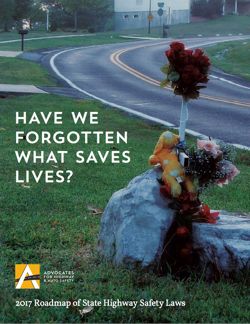Citing an “alarming two-year jump in motor vehicle crash deaths” and a falloff in traffic-safety lawmaking, the group Advocates for Highway and Auto Safety released its annual report card.
 The survey of highway safety laws gigs nine states for having ineffective distracted driving laws. Eight of those receive overall “red” ratings for anemic safety laws.
The survey of highway safety laws gigs nine states for having ineffective distracted driving laws. Eight of those receive overall “red” ratings for anemic safety laws.
Flagged for not having all-driver texting & driving laws are Arizona, Missouri, Montana and Texas. Criticized for anemic secondary-enforcement texting laws are Florida, Iowa, Nebraska, Ohio and South Dakota.
Looking solely at distracted driving laws, the 14th annual report said nine states need an “all-driver test messaging restriction,” defined as a ban on handheld texting. No credit was given to states with secondary enforcement of the texting law, such as Florida (where numerous bills have been filed to address enforcement).
The Advocates for Highway and Auto Safety study does not factor in laws addressing drivers talking on cell phones, however. It also does not consider laws regarding Internet-related functions of smartphones, such as accessing social media sites. These are the key areas most state lawmakers are addressing in the distracted driving arena, and leaves open the question of whether the safety group has kept current on the issue.
The National Safety Council, for instance, has called for outright bans on the use of cell phones while driving.
Many of these states with existing texting laws are in the process of updating to reflect the many distracting activities made possible by smartphones. Many distracted driving laws were enacted when texting was the primary computer-related use of cell phones.
Advocates for Highway and Auto Safety did not respond to a request for comment on its electronic distracted driving criteria.
In the report, researchers noted a drop-off in safety lawmaking:
“While the death and injury toll was increasing these past two years, enactment of new state safety laws was decreasing,” group president Jacqueline Gallin said. “This must change if we are serious about reversing the upward trend of highway deaths and injuries.”
The group’s report is titled: “Have we forgotten what saves lives?”
The group cited a 9 percent increase in distraction-related fatalities in 2015.
It noted that no state adopted an all-driver text messaging law in 2016.
Other laws taken into consideration in the study’s grading of states include those covering seat belt and motorcycle helmet use, child passenger safety, teen drivers and alcohol impairment.
> Read the 2017 road safety report.
> Read the 2016 road safety report.


Safety was never the aim of distracted driving laws. States saw a cash cow so for show they banned hand-held use, which in effect, encourages distracted driving since the conversation is the culprit.
100% correct Mr. Cinamon. Laws are completely ineffective. If states thought they were working they would brag about the number of accidents that were reduced each year, not the number of tickets they gave out.
I’m a retired engineer and I act as a cell phone expert in court cases where there has been an accident. I am getting more and more of these cases and I don’t want to see any more. Laws don’t work. A technical solutions must be implemented by the carriers.